height MITSUBISHI ASX 2017 Owner's Manual (in English)
[x] Cancel search | Manufacturer: MITSUBISHI, Model Year: 2017, Model line: ASX, Model: MITSUBISHI ASX 2017Pages: 458, PDF Size: 22.98 MB
Page 68 of 458

SeatE004001032251-Front seat
lTo adjust forward or backward
® p. 4-03
l To recline the seatback
® p. 4-04
l To adjust seat height (driver’s seat only)
® p. 4-05
l Armrest*
® p. 4-05
l Heated seats*
® p. 4-06
2-Rear seat
l Armrest*
® p. 4-06
Seat
4-02OGAE17E2Seat and seat belts4
Page 71 of 458
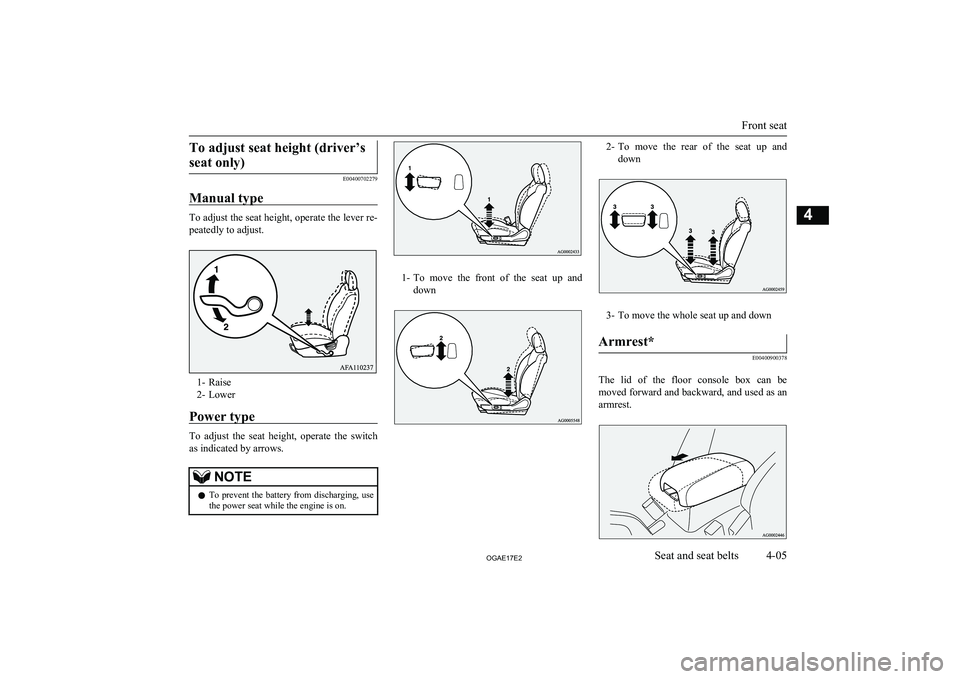
To adjust seat height (driver’sseat only)
E00400702279
Manual type
To adjust the seat height, operate the lever re-
peatedly to adjust.
1- Raise
2- Lower
Power type
To adjust the seat height, operate the switch
as indicated by arrows.
NOTEl To prevent the battery from discharging, use
the power seat while the engine is on.
1- To move the front of the seat up and
down
2- To move the rear of the seat up and
down
3- To move the whole seat up and down
Armrest*
E00400900378
The lid of the floor console box can be moved forward and backward, and used as an
armrest.
Front seat
4-05OGAE17E2Seat and seat belts4
Page 72 of 458
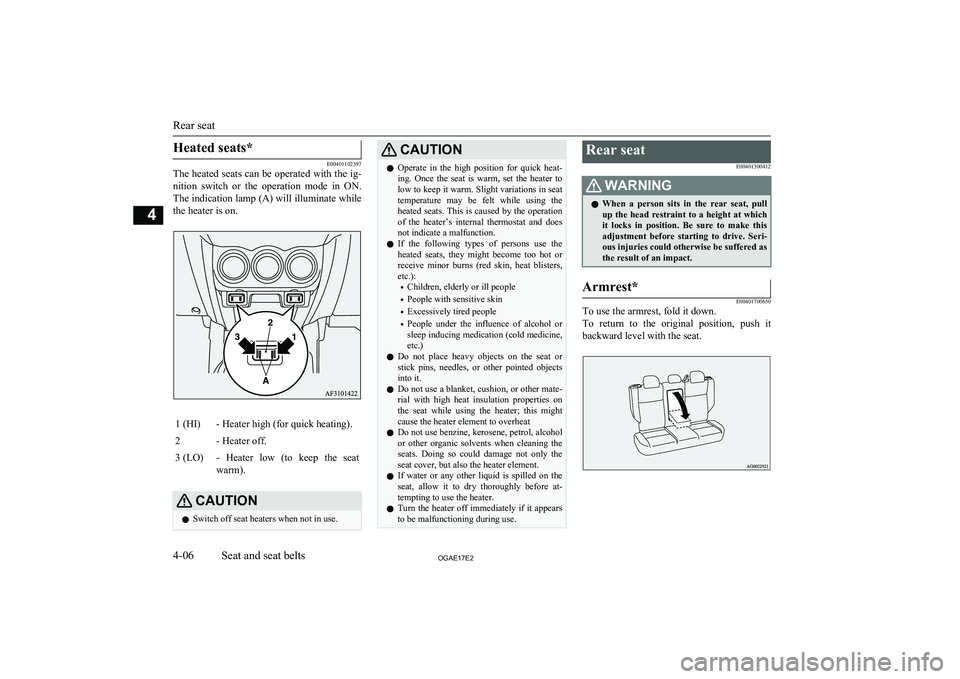
Heated seats*
E00401102397
The heated seats can be operated with the ig-
nition switch or the operation mode in ON.
The indication lamp (A) will illuminate while the heater is on.
1 (HI)- Heater high (for quick heating).2- Heater off.3 (LO)- Heater low (to keep the seat
warm).CAUTIONl Switch off seat heaters when not in use.CAUTIONlOperate in the high position for quick heat-
ing. Once the seat is warm, set the heater to low to keep it warm. Slight variations in seat
temperature may be felt while using the heated seats. This is caused by the operation
of the heater’s internal thermostat and does not indicate a malfunction.
l If the following types of persons use the
heated seats, they might become too hot or receive minor burns (red skin, heat blisters,
etc.):
• Children, elderly or ill people
• People with sensitive skin
• Excessively tired people
• People under the influence of alcohol or
sleep inducing medication (cold medicine, etc.)
l Do not place heavy objects on the seat or
stick pins, needles, or other pointed objects into it.
l Do not use a blanket, cushion, or other mate-
rial with high heat insulation properties on the seat while using the heater; this might
cause the heater element to overheat
l Do not use benzine, kerosene, petrol, alcohol
or other organic solvents when cleaning the seats. Doing so could damage not only the seat cover, but also the heater element.
l If water or any other liquid is spilled on the
seat, allow it to dry thoroughly before at-tempting to use the heater.
l Turn the heater off immediately if it appears
to be malfunctioning during use.Rear seat
E00401300412WARNINGlWhen a person sits in the rear seat, pull
up the head restraint to a height at which
it locks in position. Be sure to make this adjustment before starting to drive. Seri- ous injuries could otherwise be suffered as
the result of an impact.Armrest*
E00401700650
To use the armrest, fold it down.
To return to the original position, push it
backward level with the seat.
Rear seat
4-06OGAE17E2Seat and seat belts4
Page 73 of 458
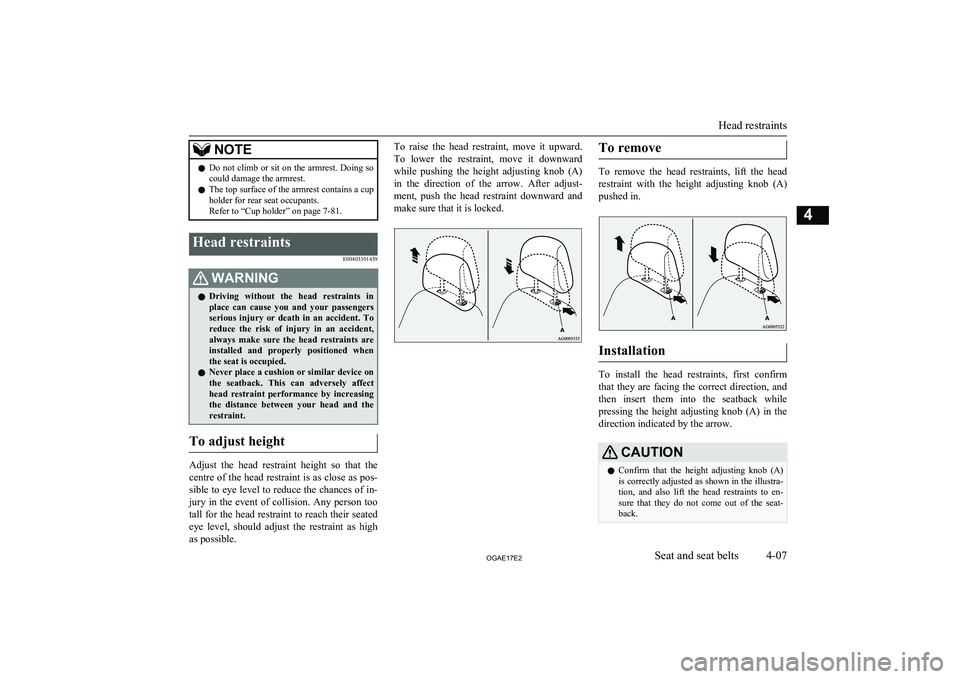
NOTElDo not climb or sit on the armrest. Doing so
could damage the armrest.
l The top surface of the armrest contains a cup
holder for rear seat occupants.
Refer to “Cup holder” on page 7-81.Head restraints
E00403301439WARNINGlDriving without the head restraints in
place can cause you and your passengers
serious injury or death in an accident. To reduce the risk of injury in an accident, always make sure the head restraints are
installed and properly positioned when the seat is occupied.
l Never place a cushion or similar device on
the seatback. This can adversely affect head restraint performance by increasing
the distance between your head and the restraint.
To adjust height
Adjust the head restraint height so that the
centre of the head restraint is as close as pos-
sible to eye level to reduce the chances of in-
jury in the event of collision. Any person too tall for the head restraint to reach their seatedeye level, should adjust the restraint as highas possible.
To raise the head restraint, move it upward.
To lower the restraint, move it downward
while pushing the height adjusting knob (A) in the direction of the arrow. After adjust-
ment, push the head restraint downward and make sure that it is locked.To remove
To remove the head restraints, lift the head
restraint with the height adjusting knob (A) pushed in.
Installation
To install the head restraints, first confirmthat they are facing the correct direction, andthen insert them into the seatback while
pressing the height adjusting knob (A) in the direction indicated by the arrow.
CAUTIONl Confirm that the height adjusting knob (A)
is correctly adjusted as shown in the illustra- tion, and also lift the head restraints to en- sure that they do not come out of the seat-
back.
Head restraints
4-07OGAE17E2Seat and seat belts4
Page 74 of 458
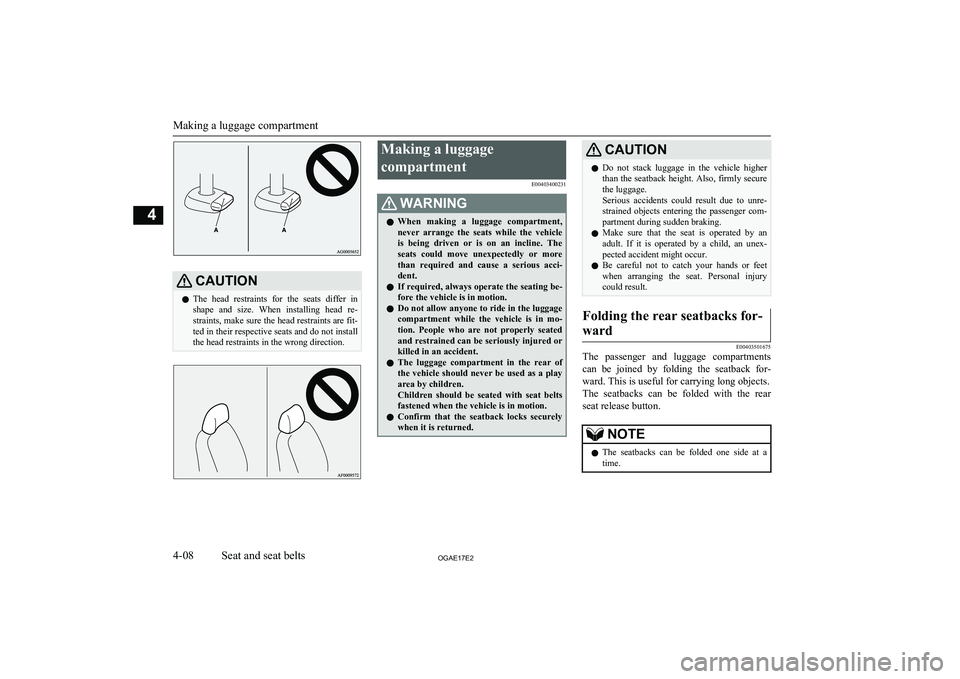
CAUTIONlThe head restraints for the seats differ in
shape and size. When installing head re- straints, make sure the head restraints are fit- ted in their respective seats and do not install
the head restraints in the wrong direction.Making a luggage
compartment E00403400231WARNINGlWhen making a luggage compartment,
never arrange the seats while the vehicle
is being driven or is on an incline. The seats could move unexpectedly or more
than required and cause a serious acci- dent.
l If required, always operate the seating be-
fore the vehicle is in motion.
l Do not allow anyone to ride in the luggage
compartment while the vehicle is in mo-
tion. People who are not properly seated
and restrained can be seriously injured or killed in an accident.
l The luggage compartment in the rear of
the vehicle should never be used as a play area by children.
Children should be seated with seat belts fastened when the vehicle is in motion.
l Confirm that the seatback locks securely
when it is returned.CAUTIONl Do not stack luggage in the vehicle higher
than the seatback height. Also, firmly securethe luggage.
Serious accidents could result due to unre-
strained objects entering the passenger com-
partment during sudden braking.
l Make sure that the seat is operated by an
adult. If it is operated by a child, an unex-
pected accident might occur.
l Be careful not to catch your hands or feet
when arranging the seat. Personal injury could result.Folding the rear seatbacks for-
ward
E00403501675
The passenger and luggage compartments can be joined by folding the seatback for-
ward. This is useful for carrying long objects. The seatbacks can be folded with the rear seat release button.
NOTEl The seatbacks can be folded one side at a
time.
Making a luggage compartment
4-08OGAE17E2Seat and seat belts4
Page 78 of 458
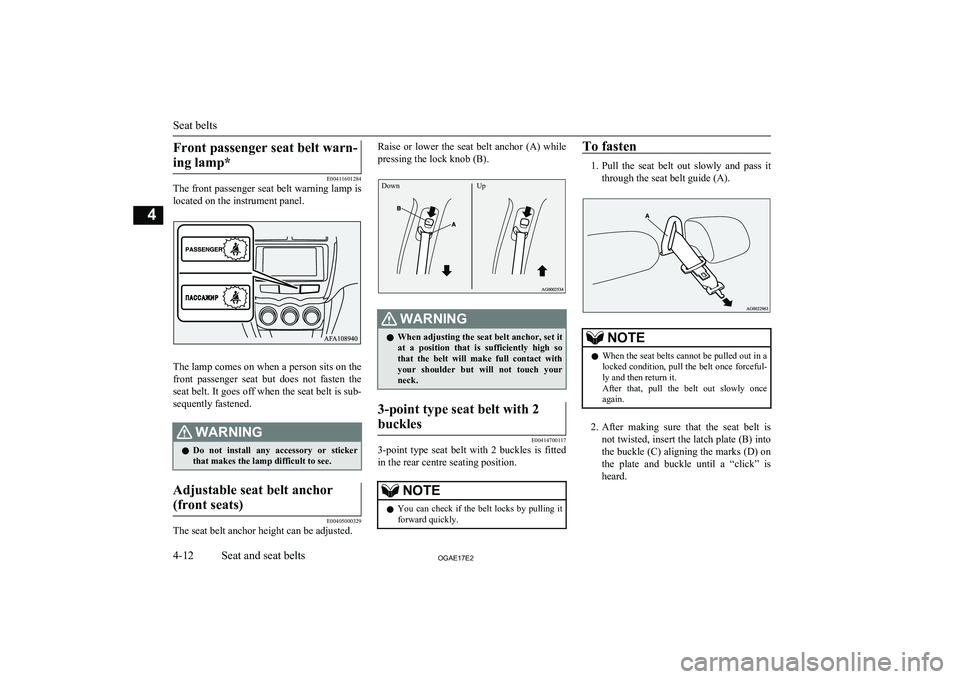
Front passenger seat belt warn-ing lamp*
E00411601284
The front passenger seat belt warning lamp is
located on the instrument panel.
The lamp comes on when a person sits on the front passenger seat but does not fasten the
seat belt. It goes off when the seat belt is sub- sequently fastened.
WARNINGl Do not install any accessory or sticker
that makes the lamp difficult to see.Adjustable seat belt anchor
(front seats)
E00405000329
The seat belt anchor height can be adjusted.
Raise or lower the seat belt anchor (A) while pressing the lock knob (B).DownUp
WARNINGl When adjusting the seat belt anchor, set it
at a position that is sufficiently high so
that the belt will make full contact with your shoulder but will not touch your
neck.3-point type seat belt with 2
buckles
E00414700117
3-point type seat belt with 2 buckles is fitted in the rear centre seating position.
NOTEl You can check if the belt locks by pulling it
forward quickly.To fasten
1. Pull the seat belt out slowly and pass it
through the seat belt guide (A).
NOTEl When the seat belts cannot be pulled out in a
locked condition, pull the belt once forceful-
ly and then return it.
After that, pull the belt out slowly once
again.
2. After making sure that the seat belt is
not twisted, insert the latch plate (B) into
the buckle (C) aligning the marks (D) on
the plate and buckle until a “click” is heard.
Seat belts
4-12OGAE17E2Seat and seat belts4
Page 82 of 458
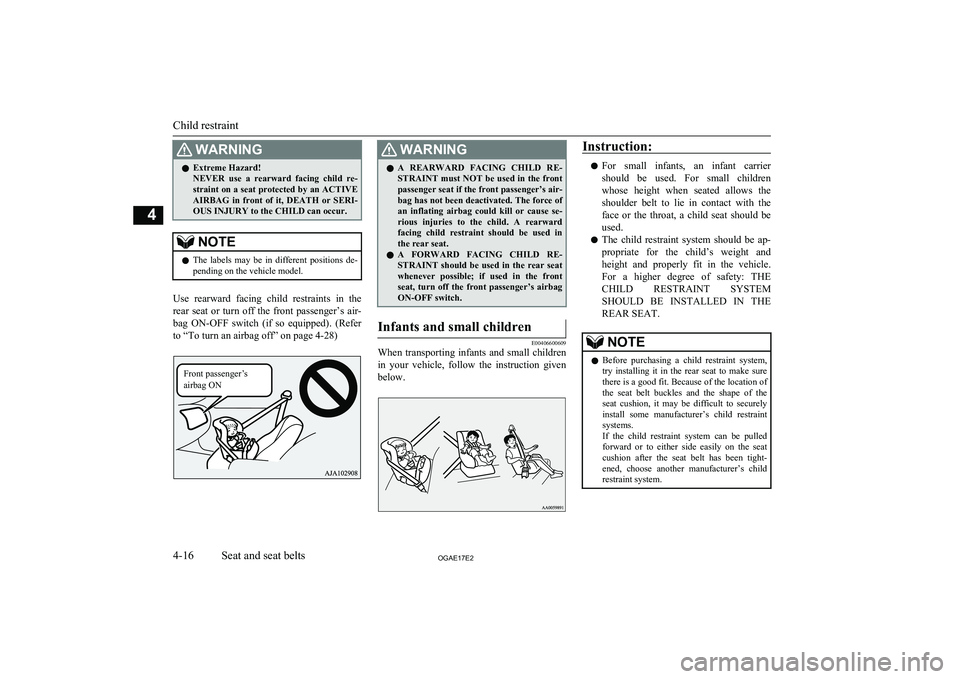
WARNINGlExtreme Hazard!
NEVER use a rearward facing child re- straint on a seat protected by an ACTIVEAIRBAG in front of it, DEATH or SERI- OUS INJURY to the CHILD can occur.NOTEl The labels may be in different positions de-
pending on the vehicle model.
Use rearward facing child restraints in the
rear seat or turn off the front passenger’s air- bag ON-OFF switch (if so equipped). (Refer
to “To turn an airbag off” on page 4-28)
WARNINGl A REARWARD FACING CHILD RE-
STRAINT must NOT be used in the front passenger seat if the front passenger’s air-
bag has not been deactivated. The force of an inflating airbag could kill or cause se-
rious injuries to the child. A rearward facing child restraint should be used in
the rear seat.
l A FORWARD FACING CHILD RE-
STRAINT should be used in the rear seat
whenever possible; if used in the front seat, turn off the front passenger’s airbag
ON-OFF switch.Infants and small children
E00406600609
When transporting infants and small children
in your vehicle, follow the instruction given below.
Instruction:
l For small infants, an infant carrier
should be used. For small children whose height when seated allows the shoulder belt to lie in contact with the
face or the throat, a child seat should be used.
l The child restraint system should be ap-
propriate for the child’s weight and
height and properly fit in the vehicle. For a higher degree of safety: THE
CHILD RESTRAINT SYSTEM
SHOULD BE INSTALLED IN THE REAR SEAT.
NOTEl Before purchasing a child restraint system,
try installing it in the rear seat to make surethere is a good fit. Because of the location of the seat belt buckles and the shape of theseat cushion, it may be difficult to securely
install some manufacturer’s child restraint
systems.
If the child restraint system can be pulled forward or to either side easily on the seatcushion after the seat belt has been tight-
ened, choose another manufacturer’s child restraint system.
Child restraint
4-16OGAE17E2Seat and seat belts4 Front passenger’s
airbag ON
Page 169 of 458
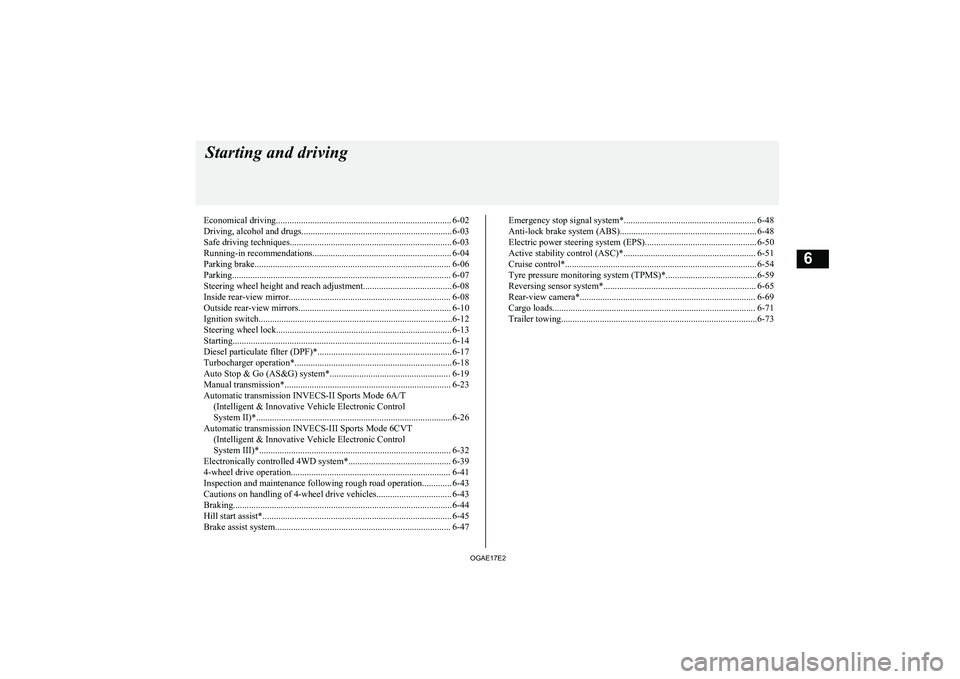
Economical driving............................................................................. 6-02
Driving, alcohol and drugs.................................................................. 6-03
Safe driving techniques....................................................................... 6-03
Running-in recommendations............................................................. 6-04 Parking brake...................................................................................... 6-06
Parking................................................................................................ 6-07
Steering wheel height and reach adjustment....................................... 6-08
Inside rear-view mirror....................................................................... 6-08 Outside rear-view mirrors................................................................... 6-10
Ignition switch.....................................................................................6-12 Steering wheel lock............................................................................. 6-13
Starting................................................................................................ 6-14 Diesel particulate filter (DPF)*........................................................... 6-17Turbocharger operation*..................................................................... 6-18Auto Stop & Go (AS&G) system*..................................................... 6-19
Manual transmission*......................................................................... 6-23 Automatic transmission INVECS-II Sports Mode 6A/T (Intelligent & Innovative Vehicle Electronic Control
System II)*......................................................................................6-26
Automatic transmission INVECS-III Sports Mode 6CVT (Intelligent & Innovative Vehicle Electronic Control
System III)*.................................................................................... 6-32
Electronically controlled 4WD system*............................................. 6-39 4-wheel drive operation...................................................................... 6-41
Inspection and maintenance following rough road operation............. 6-43
Cautions on handling of 4-wheel drive vehicles................................. 6-43
Braking................................................................................................ 6-44
Hill start assist*................................................................................... 6-45
Brake assist system............................................................................. 6-47Emergency stop signal system*.......................................................... 6-48
Anti-lock brake system (ABS)............................................................ 6-48
Electric power steering system (EPS)................................................. 6-50 Active stability control (ASC)*.......................................................... 6-51Cruise control*.................................................................................... 6-54
Tyre pressure monitoring system (TPMS)*........................................ 6-59 Reversing sensor system*................................................................... 6-65
Rear-view camera*............................................................................. 6-69 Cargo loads......................................................................................... 6-71Trailer towing......................................................................................6-73Starting and driving
OGAE17E26
Page 171 of 458
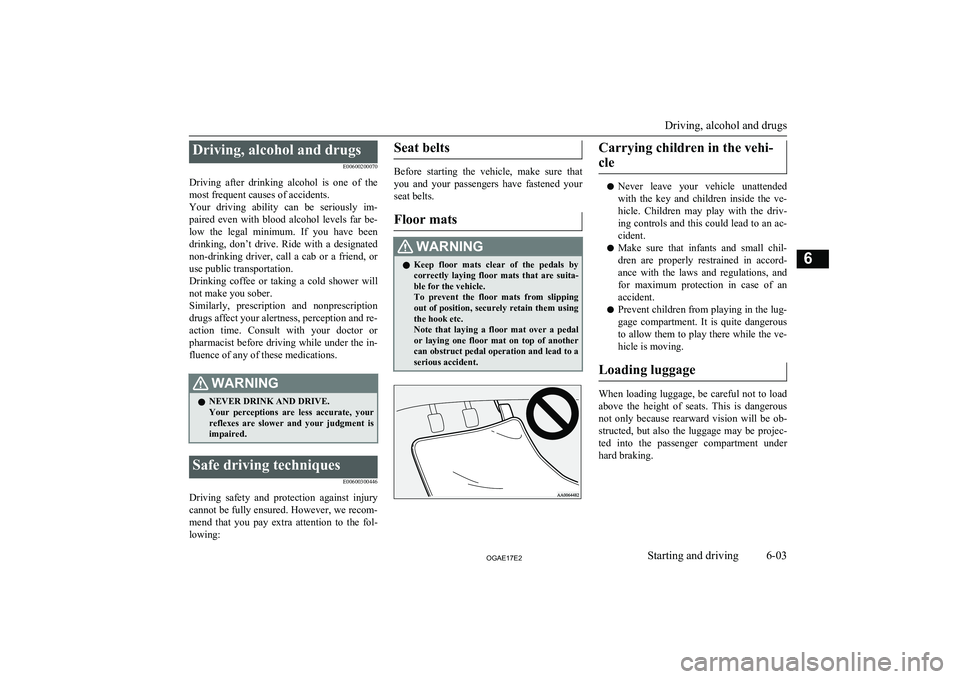
Driving, alcohol and drugsE00600200070
Driving after drinking alcohol is one of the
most frequent causes of accidents.
Your driving ability can be seriously im- paired even with blood alcohol levels far be-
low the legal minimum. If you have been drinking, don’t drive. Ride with a designated non-drinking driver, call a cab or a friend, or
use public transportation.
Drinking coffee or taking a cold shower will
not make you sober.
Similarly, prescription and nonprescription
drugs affect your alertness, perception and re- action time. Consult with your doctor or pharmacist before driving while under the in-fluence of any of these medications.WARNINGl NEVER DRINK AND DRIVE.
Your perceptions are less accurate, your reflexes are slower and your judgment is
impaired.Safe driving techniques
E00600300446
Driving safety and protection against injury
cannot be fully ensured. However, we recom- mend that you pay extra attention to the fol-
lowing:
Seat belts
Before starting the vehicle, make sure that
you and your passengers have fastened your seat belts.
Floor mats
WARNINGl Keep floor mats clear of the pedals by
correctly laying floor mats that are suita-
ble for the vehicle.
To prevent the floor mats from slipping out of position, securely retain them usingthe hook etc.
Note that laying a floor mat over a pedal
or laying one floor mat on top of another can obstruct pedal operation and lead to a
serious accident.Carrying children in the vehi-
cle
l Never leave your vehicle unattended
with the key and children inside the ve-hicle. Children may play with the driv-
ing controls and this could lead to an ac- cident.
l Make sure that infants and small chil-
dren are properly restrained in accord-
ance with the laws and regulations, and
for maximum protection in case of an accident.
l Prevent children from playing in the lug-
gage compartment. It is quite dangerous
to allow them to play there while the ve- hicle is moving.
Loading luggage
When loading luggage, be careful not to load above the height of seats. This is dangerous
not only because rearward vision will be ob- structed, but also the luggage may be projec-ted into the passenger compartment underhard braking.
Driving, alcohol and drugs
6-03OGAE17E2Starting and driving6
Page 176 of 458
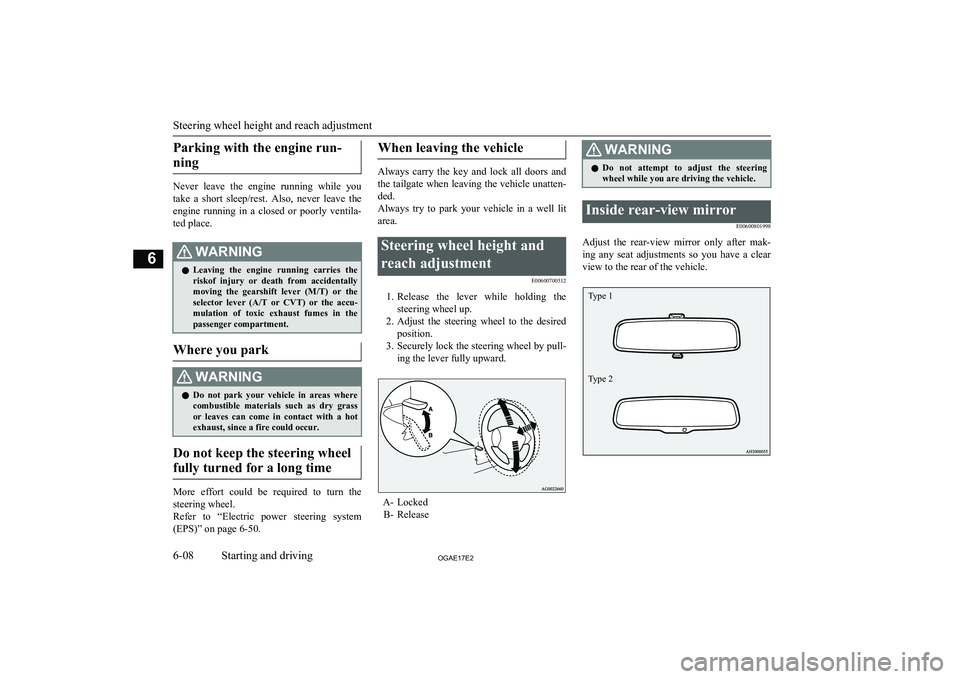
Parking with the engine run-ning
Never leave the engine running while you
take a short sleep/rest. Also, never leave the engine running in a closed or poorly ventila-
ted place.
WARNINGl Leaving the engine running carries the
riskof injury or death from accidentally
moving the gearshift lever ( M/T) or the
selector lever ( A/T or CVT) or the accu-
mulation of toxic exhaust fumes in the
passenger compartment.
Where you park
WARNINGl Do not park your vehicle in areas where
combustible materials such as dry grass
or leaves can come in contact with a hot exhaust, since a fire could occur.
Do not keep the steering wheel
fully turned for a long time
More effort could be required to turn the
steering wheel.
Refer to “Electric power steering system (EPS)” on page 6-50.
When leaving the vehicle
Always carry the key and lock all doors and
the tailgate when leaving the vehicle unatten-
ded.
Always try to park your vehicle in a well lit
area.
Steering wheel height and
reach adjustment E00600700512
1.Release the lever while holding the
steering wheel up.
2. Adjust the steering wheel to the desired
position.
3. Securely lock the steering wheel by pull-
ing the lever fully upward.
A- Locked B- Release
WARNINGl Do not attempt to adjust the steering
wheel while you are driving the vehicle.Inside rear-view mirror
E00600801998
Adjust the rear-view mirror only after mak-
ing any seat adjustments so you have a clear
view to the rear of the vehicle.
Steering wheel height and reach adjustment
6-08OGAE17E2Starting and driving6 Type 1
Type 2